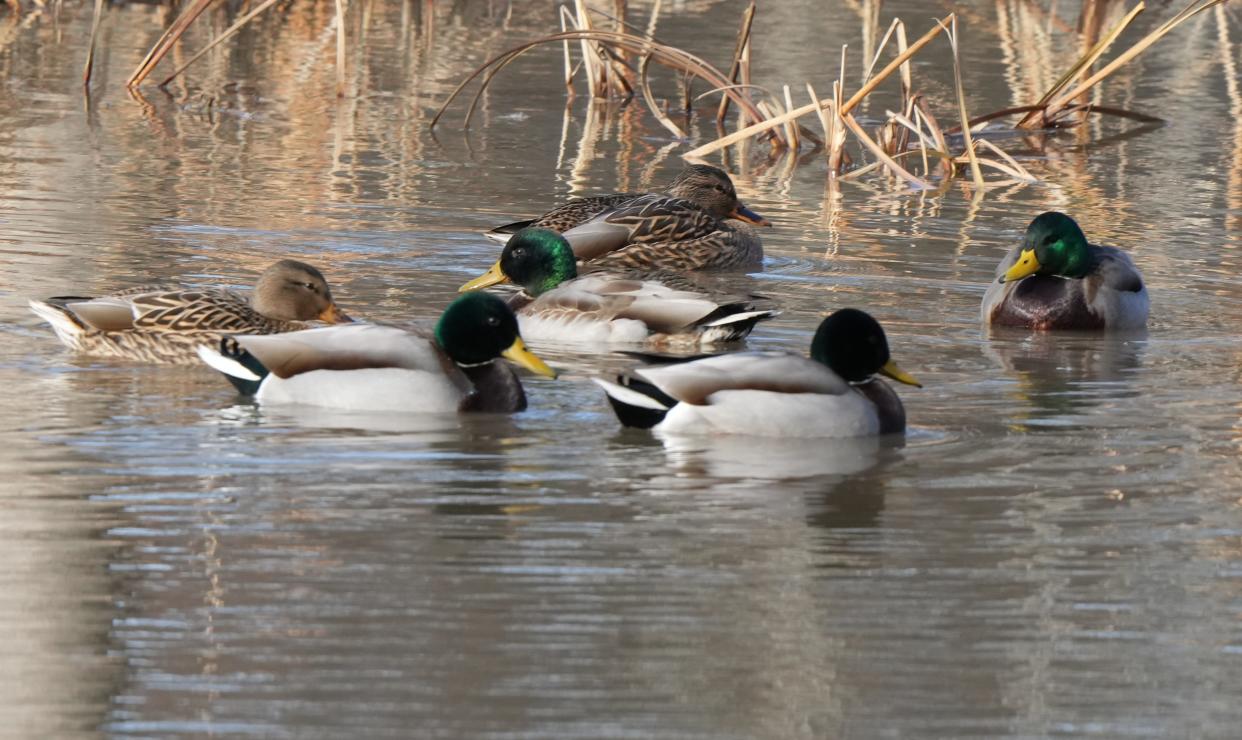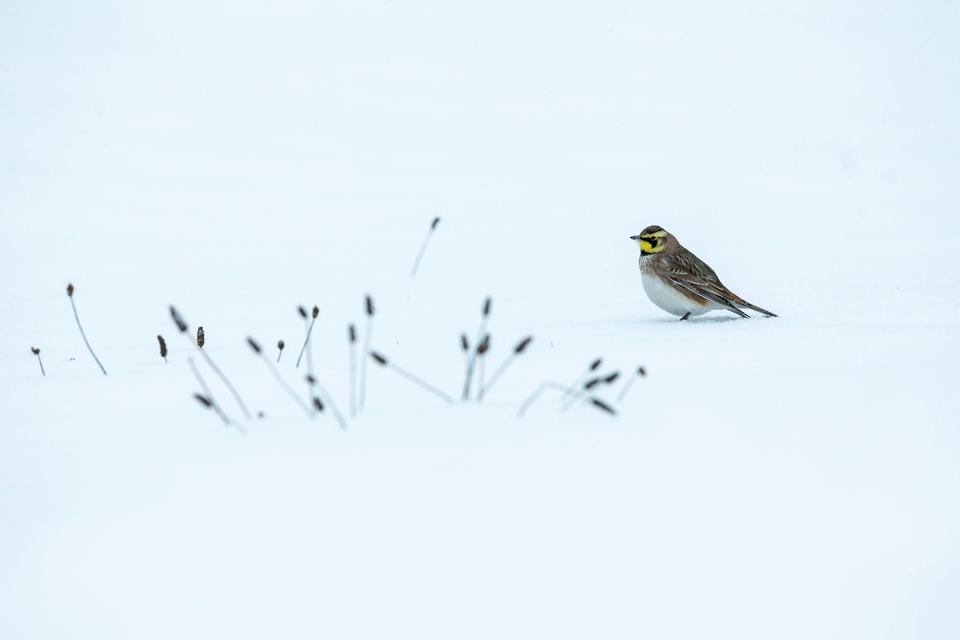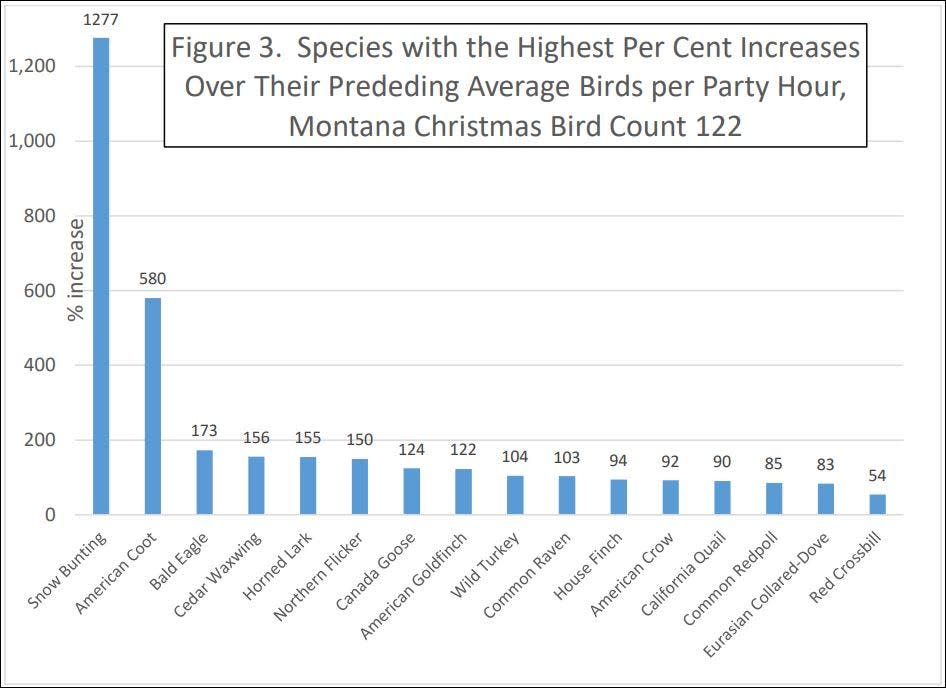Christmas Bird Count reveals more larks, fewer warblers

On a cold winter’s morning, one week before Christmas, 22 "birders" crisscrossed Cascade County's streams, fields and woodlands to take the measure of wild bird populations. With temperatures dipping into the single digits and an arctic wind bearing down from the north, volunteers from the Upper Missouri Breaks chapter of the National Audubon Society successfully identified 59 different species of birds, including more than 21,000 individuals.
Statewide numbers from the 2022 Christmas Bird Count, held on Dec. 17, are only now beginning to trickle in. A complete statewide compilation of observations from Montana’s 33 active bird count “circles” will likely be published in late March or early April; however, the tally of birds observed by Great Falls area birders is already available.
As with every Christmas Bird Count there were both some expectations confirmed and some surprises revealed.
“One of the big surprises we saw this year was the number of Horned Larks we counted,” said Nora Gray, one of the primary organizers of this year's Christmas Bird Count.
Two-hundred-forty Horned Larks were observed in the Great Falls area this year, more than double the 114 spotted in last year’s bird count. The prairie songbird, and North America's only native lark, can be found in flocks across open fields in the winter where they can be seen running across the ground examining the soil and stubble in search of seeds.
A 114% increase in any species with the passage of a single year may seem extreme, but ornithologists note that localized bird populations can shift dramatically from year to year, especially among prairie songbirds.
Compilers following the 2021 Christmas Bird County were astounded to have documented a more than 12-fold increase in the number of Snow Buntings reported across Montana that year, exploding from fewer than 940 reported sightings in Dec. 2020 to more than 11,000 identified on Dec. 14, 2021.

The Audubon Society’s statewide bird count compiler, Rosemary Leach, noted that more than half of the Snow Buntings had been tallied from a single circle in Fort Peck, and that specific regional conditions around the Fort Peck area probably accounted for a large percentage of the sudden increase.
“(Fort Peck compiler John Carlson) had noticed that there were many grain fields left unharvested from last fall,” Leach recounted in her 2022 bird survey. “If conditions allowed the grain to be accessible (so not buried by snow), the birds may have congregated to take advantage of that food source.”
The prevalence of Horned Larks this year was a bright spot for prairie songbirds in Montana, many of which have experienced steep population declines in recent decades.
For the second year in a row Christmas Bird Count observers recorded zero Bohemian Waxwings, a beautiful species of open forest songbird whose trilling voice is most commonly heard in the prairie provinces of western Canada. As recently as the 1980s Bohemian Waxwing numbers around Great Falls in December expanded to 1,000 birds or more. Now it appears that the insect- and berry-loving songbird has retreated to more northerly climes.
The precise implications are difficult to evaluate.
"(Many of these birds) are here one winter,” Gray noted, “then they're somewhere else another winter. They move around in big bunches. You may have some in your yard for three days and then they're gone. Some years they'll stick around all winter and other years most of they're numbers will move south. That's why doing these counts over a period of many years and all across the country is so important to gauge the health of the species.
Montana warblers are also species of concern. Sightings of the Yellow-rumped warblers and Wilson’s Warblers are in decline across the state, with few or any reported recently in the annual December tally.
“We just don’t see the number of warblers anymore like we used to way back when,” Gray said. “The birds that have the most trouble are the ones who are married to one species of plant - if they're what we call a 'specialist' for feeding," Gray said. "The birds that are what we call 'generalists' — in other words, depending upon what season it is they'll eat different things — those birds have a better long-range survival rate."
What has not been a surprise is the prevalence of the Canada goose and other waterfowl over-wintering in the Great Falls area.
Among the 59 species and 21,163 birds identified last December, nearly 75% were members of two species, Canada geese and Mallard ducks. Among the 21,163 birds counted on Dec. 17, 2022, these two species accounted for 15,735.
“Canada geese are the biggest number that we have every year, and Mallard ducks are second,” Gray noted. “Their numbers are just huge.”
It wasn’t always this way.
According to Audubon Society records, up until the 1960s Canada geese overwintering around Great Falls was an uncommon occurrence.
"I know historically from what I've read that there were not many geese around in the wintertime before the 1960s," Gray said "In 1959 there were only 53 Canada geese counted, and the next year there weren't any. It may have been just one person doing the count alone back then, but still. The numbers have dramatically increased since then."
The dramatic increase in Canada geese and Mallard ducks likely began with the creation of the Benton Lake Wetland Management District in 1929, and a marked increase in grain production in and around central Montana in the 1940s.
Tracking the fluctuations in bird populations such as the Canada goose is only one of the things achieved by the Christmas Bird Count. The count began as a proposed alternative to traditional Christmas bird hunts that leveled tens of thousands of migratory birds at the end of the 19th century.

“In 1900, Dr. Frank Chapman, founder of Bird-Lore — which evolved into Audubon magazine — suggested an alternative to that tradition," the Audubon Society states. "Rather than hunting and killing birds, Chapman's idea was to count them. That turned into the Audubon Christmas Bird Count, now in its 122nd year.
The count produces the most comprehensive data set depicting the fluctuation, range and movement of bird populations across the North American and European continents. Scientists rely on this trend data to better understand how birds and the environments in which they live are faring, and what needs to be done to protect them.
Data from annual Christmas Bird Counts are at the core of hundreds of peer-reviewed scientific studies and help to inform decisions made by the U.S. Fish and Wildlife Service, the Department of the Interior, and the Environmental Protection Agency.
Because birds are early indicators of environmental threats, the Audubon Christmas Bird Count has also become a vital survey of North America and Western Hemisphere ecosystems.
“The Christmas Bird Count is meant to be fun, but it’s also real science,” an Audubon Society informational release states. “Data collected by observers allows Audubon researchers, biologists, and wildlife agencies to study the long-term health and status of bird populations across North America. The data helps conservationists identify environmental concerns, and devise strategies to protect birds and their habitats.”
Central Montana’s link to the Christmas Bird Count goes back to 1911, when pioneer birder Berners Kelly set out on a cold Christmas morning to count 190 birds; 27 Common Goldeneyes, a Swainson's hawk, three Downy woodpeckers, four Magpies, 150 Ruby-crowned Kinglets and five Northern shrikes
Montana’s Christmas Bird Count has fluctuated in the years since, only evolving into a regular event in the last half century. The Christmas Bird Count was held sporadically until 1960 and was only resumed in earnest in the Great Falls area in 1981. Since then, it's been an annual Upper Missouri Breaks Audubon project.
“This is our 50th this year in this circle,” Gray said in recognizing the anniversary.
To learn more about the Upper Missouri Breaks Chapter of the Audubon Society go the group's website at www.umbaudubon.com. There you can learn about local birding opportunities, sign up to receive their newsletter, and join in on their regular series of remote lectures.
The 15 most abundant species of the 2022 Christmas Bird Count
Species | Number Counted | Species Origin |
Canada Goose | 13,026 | Native |
Mallard Duck | 2,709 | Native |
House Sparrow | 1,347 | Introduced |
Common Goldeneye Duck | 986 | Native |
European Starling | 484 | Introduced |
Rock Pigeon | 466 | Introduced |
Horned Lark | 240 | Native |
Eurasian Collard Dove | 236 | Introduced |
House Finch | 228 | Native |
Black-billed Magpie | 178 | Native |
American Coot | 170 | Native |
Black-capped Chickadee | 143 | Native |
Bufflehead Duck | 125 | Native |
Ring-necked Pheasant | 118 | Introduced |
Wild Turkey | 118 | Introduced |
This article originally appeared on Great Falls Tribune: Great Falls Christmas Bird Count reveals Horned Larks as big winners

